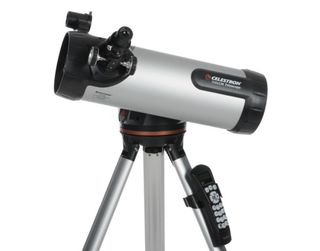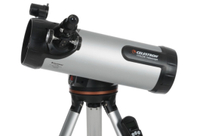Get 12% off the Celestron 114LCM Computerized Telescope, now just $309.58
Tour the universe with the latest in telescope technology — and at a great discount

Editor's Note: This deal is now over as the discounted units are out of stock. Read our regularly updated list of telescopes and binoculars from Orion, Celestron, Meade Instruments, Sky-Watcher and Vixen for other great offers instead.
Promoting fuss-free assembly and operation, the Celestron 114LCM Computerized Telescope is one of the easiest ways to get into skywatching. And now with a 12% discount at Amazon, you don't need to break the bank in order to get the latest in telescope technology.
Along with a sturdy aluminum tripod and a database that allows the observer to slew to over 4,000 astronomical objects at the touch of a button, the Celestron 114LCM comes with a great selection of accessories including a 25 mm and 9 mm eyepiece, accessory tray and a StarPointer finderscope.
With the SkyAlign technology, getting the telescope calibrated and ready for rewarding observations is a simple affair: just center any three bright targets in the telescope's field of view and the GoTo's computer will work out the date, time and your location. The 114LCM is also able to take you on a pre-programmed tour if you can't decide what to study.
Celestron 114LCM Computerized Telescope: $349.95 $309.58 at Amazon
Now with $40.37 off along with free delivery and returns, the Celestron 114LCM Computerized Telescope offers exquisite optics as well as the ability to scan the cosmos at the touch of a button. The 4.5-inch (114 mm) aperture is great for picking out planets, craters, nebulas and galaxies.
This Newtonian reflector offers magnifications of 40x and 111x but given the telescope's versatile 1.25-inch (31.75 mm) eyepiece fitting, skywatchers are able to accessorize the telescope even further, pushing the optical limits to 16x and 269x.
Through the field of view, skywatchers can enjoy a menagerie of night-sky wonders and at high definition, devoid of any optical distortion. The 4.5-inch (114 mm) aperture guzzles light to pick out faint and far away targets, while the fully coated optics ensure that views are crystal clear with dazzling contrast.
Whether you're looking to scan craters along the moon's terminator, track down bright galaxies or nebulas, split double stars or hunt for the Trapezium cluster at the heart of the Orion Nebula (Messier 42), the Celestron 114LCM Computerized Telescope makes touring the universe a breeze from one observing session to the next.
Get the Space.com Newsletter
Breaking space news, the latest updates on rocket launches, skywatching events and more!
Be sure to check out more of Space.com's deals on telescopes and binoculars from Orion, Celestron, Meade Instruments, Sky-Watcher and Vixen.
Celestron 114LCM Computerized Telescope: $349.95 $309.58 at Amazon
Now with $40.37 off along with free delivery and returns, the Celestron 114LCM Computerized Telescope offers exquisite optics as well as the ability to scan the cosmos at the touch of a button. The 4.5-inch (114 mm) aperture is great for picking out planets, craters, nebulas and galaxies.
Join our Space Forums to keep talking space on the latest missions, night sky and more! And if you have a news tip, correction or comment, let us know at: community@space.com.

Gemma currently works for the European Space Agency on content, communications and outreach, and was formerly the content director of Space.com, Live Science, science and space magazines How It Works and All About Space, history magazines All About History and History of War as well as Science, Technology, Engineering, Arts and Mathematics (STEAM) kids education brand Future Genius. She is the author of several books including "Quantum Physics in Minutes", "Haynes Owners’ Workshop Manual to the Large Hadron Collider" and "Haynes Owners’ Workshop Manual to the Milky Way". She holds a degree in physical sciences, a Master’s in astrophysics and a PhD in computational astrophysics. She was elected as a fellow of the Royal Astronomical Society in 2011. Previously, she worked for Nature's journal, Scientific Reports, and created scientific industry reports for the Institute of Physics and the British Antarctic Survey. She has covered stories and features for publications such as Physics World, Astronomy Now and Astrobiology Magazine.

